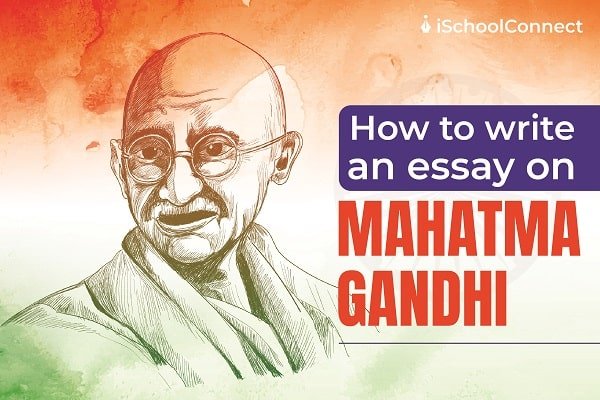Table of Contents
Life of Gandhi Ji
Mohandas Karamchand Gandhi, also known as Mahatma Gandhi, who was born on 2nd October 1869 in Porbandar. Mahatma Gandhi was an Indian writer, social activist, politician, and lawyer. He also founded the nationalist movement against the British invaders’ rule in India.
Avoiding violence while dedicating to a singular cause. As a result of his efforts, people remember him as the “Father of the Nation.”
Aside from that, he held religious beliefs. He and his family have been following a form of Vaishnavism, one of Hinduism’s major traditions, infused with the morally strict tenets of Jainism. Jainism is an important Indian faith that teaches concepts such as asceticism and nonviolence. Beliefs shaping Gandhi’s spiritual outlook later in life were influenced by his upbringing in some way. As he encountered new belief systems, his understanding of faith shifted. Mahatma Gandhi attended law school at the University College London.
Knowing Mahatma Gandhi’s contributions to India’s struggle for independence is crucial for every citizen. If you are thinking to pen his life story, then write a compelling Mahatma Gandhi essay adding these pointers!
How to write an essay on Mahatma Gandhi

The first step to writing an essay on Mahatma Gandhi in English is to research your content. So, devise a structure to deliver an essay in 500 to 1000 words. Most excellent essays on historic personalities and environmental topics like global warming follow a specific sequence. As a result, this allows your readers to gain as much information as possible in limited words.
The suggested structure for a typical essay on Mahatma Gandhi includes:
- Mahatma Gandhi – Who Was He?
- Youth
- Education
- Religious beliefs
- Contribution to India’s Independence Movement
If you want to write an engaging essay on Mahatma Gandhi in English, then you must present the information coherently. Also, we’d suggest you go through some essays online to get an idea about the structure.
Key facts for a short essay on Mahatma Gandhi

Here are some key facts that can add value to each section of your Mahatma Gandhi essay. These facts are crucial to understanding Mahatma Gandhi’s significance in the past and his relevance today!
Mahatma Gandhi – Who was he?
- Mahatma Gandhi’s full name was Mohandas Karamchand Gandhi.
- He was the leader of the nationalist non-violence movement against British rule in India.
- People respected Gandhiji for his doctrine of ‘Satyagraha’, a movement to achieve social and political progress.
- Followers referring to “Mahatma” or “Great Souled”.
Youth
- Mahatma Gandhi was the youngest child of his father’s 4th wife. His father was the chief minister of Porbandar.
- People described Gandhi as “restless as mercury” during his early childhood. He particularly enjoyed roaming around and playing.
- As he grew older, Gandhi had a short and spindly stature which kept him away from athletics.
- Talking about his interests, he would spend a considerable amount of time reading the Bhagavad-Gita, Tolstoy, and the Bible with great enthusiasm. This religious imagination was the center of his doctrine in his later years. You can build upon this fact as the focal point of your Mahatma Gandhi essay.
Education
- Mahatma Gandhi graduated with a degree in law from the University of Bombay. Soon after, he got into the University College London.
- He graduated from University College London in 1891 and was admitted to England’s bar exam.
- Then, he returned to Bombay and tried to open a law practice which was to no avail.
- Soon after, he went to work for an Indian firm in Natal in South Africa. During his travel and stay, Gandhi experienced widespread racism and discrimination.
Accomplishment through activism
- Initially, Gandhi’s campaigns aimed to combat the British regime’s treatment of Indians as second-class citizens.
- They eventually turned their attention to completely defying the British regime, which they accomplished in the years immediately following World War II.
- The victory was marred by sectarian violence within India between Hindus and Muslims, which necessitated the establishment of two independent states—India and Pakistan—rather than a single unified India.
Religious beliefs

- Gandhi read David Thoreau’s ‘On the Duty of Civil Disobedience’, which inspired his devotion to non-violence.
- Also, the literature of Hindi Bhakti saints significantly influenced him.
- At the age of 57, Gandhi declared that he was an ‘Advaitist Hindu’ and supported the Dvaitist religious pluralism.
- The London lifestyle reinforced the values that he had grown up with within his religious household. Emphasizing his London lifestyle and challenges in your Mahatma Gandhi essay can help readers understand his beliefs.
- Several theories describe the possible religious influence on Gandhi. For example, N. A. Toothi, in 1935, stated that Gandhi may have been influenced by the teachings of the Swaminarayan tradition of Hinduism.
Contribution of Mahatma Gandhi to India’s Independence Movement
- Gandhi returned to Bombay in January 1915 and spent the next 3 years hovering on the boundary of Indian politics. He declined to join any imminent political agitation. Instead, he supported the British war effort by recruiting soldiers for the Army.
- In February 1919, the British pushed through the Indian opposition with the Rowlatt Acts. The empowering authorities to imprison Indians without trial suspecting of sedition.
- As a result, Gandhi announced a satyagraha struggle that proved to be a virtual political earthquake.
- Several violent outbreaks followed, particularly the Massacre of Amritsar. Thereafter, Martial Law happened, which was an important aspect of the Indian Independence Movement. You should highlight this outbreak in your Mahatma Gandhi essay.
- By 1920, Gandhi was a dominant political figure commanding an influence that India never experienced before.
- On 10th March 1922, Britishers arrested Gandhi for sedition with a sentence of 6 years. Releasing in 1924 after surgery for appendicitis.
- He undertook a fast of 3 weeks in 1924 to make Indians follow a path of nonviolence. In December 1924, Gandhi became the president of the Congress Party.
- Mahatma Gandhi began the Civil Disobedience Movement in 1930. It was a practice that involved refusing to obey any orders or laws that were oppressive. Consequently, this strategy and its enforcers faced significant violence and brutality. But, this did not deter them at all.
Gandhi’s strategy soon established him as one of the most well-known figures in India’s history and struggle for independence. Adding these facts to your essay can help readers develop a clear understanding of Mahatma Gandhi’s prominence and life story.
Key Takeaways
- Mahatma Gandhi was among the most prominent leaders of India’s Independence Movement. He continues to be an inspiration to many.
- Learning the most notable facts about Gandhi’s life can help writers structure a short essay on Mahatma Gandhi.
- Developing a structure for your Mahatma Gandhi essay is key to ensuring that you present all relevant information in a concise manner.
- Understanding the right information to add to your essay can help you create a compelling and engaging piece.
Now that you know what to add to your essay, take out that notepad and start scribbling! We hope you enjoyed reading this blog! If you have any suggestions/questions, reach out to us! Also, don’t forget to drop a comment below and share your thoughts about the blog!
Liked this blog? Read next : Top Hindi college essay topics for classes 6 to 12
FAQs
Q1. When was The Salt March conducted?
Answer – The Salt March to Dandi began on March 12, 1930, and ended on April 6, 1930.
Q2. Who did Gandhi call ‘Harijans’?
Answer – Gandhi created numerous campaigns uplifting the lives of the lowest caste in India, referring to as untouchables. Gandhi called them ‘Harijans’ or ‘Children of God’.
Q3. When did Mahatma Gandhi die?
Answer – Mahatma Gandhi died on January 30, 1948. He was shot thrice in the chest by assassins.







